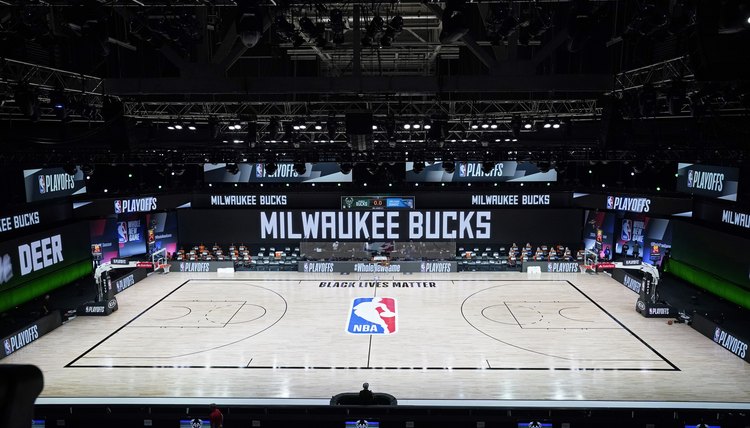What Is the Size of a Half-Court Basketball Court?

In an official NBA, WNBA, NCAA and high school basketball game, ten players are on the court at once, with five on each team. If there are fewer than ten players, however, half-court pickup basketball is the next best option. While some of the rules are not directly in line with regulation basketball rules, half-court pickup games are utilized by players of all ages and levels of play.
Half-Court Basketball Rules
1. First possession: Because there is no jump-ball in half-court pickup games, the first possession is often determined by a player "shooting for it."
- One player is selected from either one of the teams to shoot a shot, typically from the three-point line
- If the player makes the shot, their team gets first possession of the ball
- If the player misses, the other team gets first possession
2. Taking it back: With both teams shooting on the same basket, it is important to know who actually has possession of the ball in a given situation. After a missed shot, the ball must be "taken back" to officially change possession.
- When the ball is rebounded, the rebounder must dribble or pass beyond the 3-point line in order to change who is in possession of the ball
- In some backyard pickup games, this rule is not applied when the ball does not hit the rim, backboard or is stolen; in that case, the defensive team can go directly to the basketball hoop without taking the ball back
3. Counting the score: Keeping track of the score is essential to determining who wins the game; however, half-court basketball may have different rules when it comes to counting how much each basket is worth.
- Made shots that are taken inside the three-point line are worth one point
- Made shots taken beyond the three-point line are worth two points
- Instead of shooting free throws, the team that is fouled gets the ball at the top of the key to start a new possession
4.Checking up: After a made basket or dead ball situation, the ball is checked up at the top of the key to represent that both teams are ready to begin play, and the ball is in possession.
- The offensive player stands at the top of the key and passes the ball to the defender in front of him, usually around the free throw line
- The defender then passes the ball back to the offensive player, signifying that the ball is live and in play
- Once the offensive player has the ball, they cannot make a move without first passing the ball to one of his teammates
5. Make it, take it: Anytime a player scores a basket in a half-court game, their team retains possession of the ball until they miss a shot or turn the ball over.
WATCH: Time Lapse of Backyard Sport Court Being Built
Full court and half-court dimensions
Basketball court dimensions vary by age level:
- Youth: 74 feet long by 42 feet wide
- High school basketball court: 84 feet long by 5o feet wide
- College basketball court/Men's professional basketball court: 94 feet long by 50 feet wide
- FIBA basketball court: 28 meters by 15 meters
- Women's professional basketball court: 28 meters by 15 meters
Half-court dimensions use the same width, but cut the length of the courts in half at the half-court line, leaving one three-point arc, one foul line, one free throw lane, and one of the baselines or end lines to make up the court.
Many outdoor basketball courts, like backyard courts and sport courts, use these basketball court dimensions to measure line distances and make these home courts as similar to indoor basketball courts as possible.
- Youth: 37 feet long by 42 feet wide
- High school: 42 feet long by 5o feet wide
- College/NBA court: 47 feet long by 5o feet wide
References
Writer Bio
Based in Austin, Texas, Jolie Johnson has been in the fitness industry for over 12 years and has been writing fitness-related articles since 2008 for various websites. She received her Bachelor of Arts in English and philosophy from the University of Illinois.
